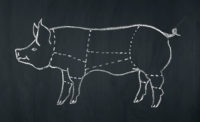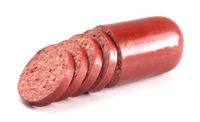 Approximately 20% of pork in the U.S. is consumed as sausage products. Fat is a main ingredient of sausages but can be quite variable in quality. The quality and consistency of fat contributes to the processing, textural and sensory characteristics of the final product.
Approximately 20% of pork in the U.S. is consumed as sausage products. Fat is a main ingredient of sausages but can be quite variable in quality. The quality and consistency of fat contributes to the processing, textural and sensory characteristics of the final product.
Generally, unsaturated, soft pork fat is considered to be poor quality, due to issues with shelf-life and processing. Increased unsaturation in fat can occur from changes in feed ingredients and inclusion of alternate fat sources during product formulation. Therefore, we were interested in determining the effect of increased unsaturation in fat on the quality and shelf-life of fresh pork sausages.
Unsaturated fatty acids were increased in pork fat used to manufacture fresh sausage and bologna by feeding cull sows 60% dried distillers’ grains with solubles (DDGS), a feed ingredient with high levels of unsaturated fatty acids. Fat from sows fed no DDGS was used for comparison.
We expected that fresh sausage and bologna with increased unsaturated fatty acids would have poorer sensory and processing characteristics, and shortened shelf-life. Fresh sausage patties (25% fat) were manufactured, formed and stored frozen for up to 12 weeks. Bologna was also manufactured with a 70:30 lean:fat ratio.
Iodine value was increased in sausages made with fat from DDGS-fed sows, indicating that these sausages contained a greater proportion of unsaturated fat. These sausages also exhibited increased fat smearing and reduced fat particle size upon visual evaluation. The unsaturated sausages had less moisture loss during cooking, but juiciness, texture and off-flavor as judged by a sensory panel were unaffected. Hardness was reduced in unsaturated sausages. Lipid oxidation was also increased at 3 and 6 weeks of frozen storage in sausages from DDGS-fed sows, suggesting these sausages may have a slightly shorter shelf-life than sausages with more saturated fat.
In bologna, iodine value was also increased by using fat from DDGS-fed sows. Cooked yield after processing in the smokehouse was reduced from 96% to 94.3% in the more unsaturated bologna. Mouthfeel, mouth coating and texture as rated by a sensory panel, however, were unaffected by fat source, though the force required to shear bologna slices was increased marginally (0.65 to 0.84 kg) in more unsaturated bologna.
Overall, despite an increase in unsaturation in fresh sausage and bologna, changes in sensory and lipid oxidation were minimal. The reduction in processing yield in more unsaturated bologna, however, warrants further investigation, as does the increased fat smearing in fresh sausages.
In light of changes in swine diets that increase the unsaturation of pork fat, along with consumers’ desires for reduced saturated fat in meat products, understanding the impact of increased unsaturation on pork sausage quality will require future research.




Report Abusive Comment